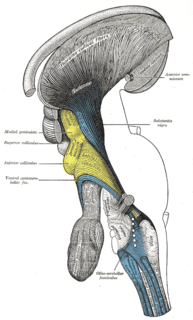This page is based on this
Wikipedia article Text is available under the
CC BY-SA 4.0 license; additional terms may apply.
Images, videos and audio are available under their respective licenses.

The thalamus is a large mass of gray matter in the dorsal part of the diencephalon of the brain with several functions such as relaying of sensory signals, including motor signals to the cerebral cortex, and the regulation of consciousness, sleep, and alertness.

Brodmann area 19, or BA 19, is part of the occipital lobe cortex in the human brain. Along with area 18, it comprises the extrastriate cortex. In humans with normal sight, extrastriate cortex is a visual association area, with feature-extracting, shape recognition, attentional, and multimodal integrating functions.

Thalamocortical radiations are the fibers between the thalamus and the cerebral cortex.

The lectisternium was an ancient Roman propitiatory ceremony, consisting of a meal offered to gods and goddesses. The word derives from lectum sternere, "to spread a couch." The deities were represented by their busts or statues, or by portable figures of wood, with heads of bronze, wax or marble, and covered with drapery. It has also been suggested that the divine images were bundles of sacred herbs tied together in the form of a head, covered by a waxen mask so as to resemble a kind of bust, rather like the straw figures called Argei. These figures were laid upon a couch (lectus), the left arm resting on a cushion in the attitude of reclining. The couch was set out in the open street, and a meal placed before it on a table.
The orienting system describes a system whereby reflexive and more controlled eye movements are initiated as part of the attentional response. The orienting system involves the superior colliculus, magno cells in the pulvinar (thalamus) and the secondary and tertiary areas of the extrastriate cortex e.g. V5. The orienting system follows the second 'geniculate' pathway. This pathway projects first to the superior colliculus and then to the pulvinar of the thalamus before projecting mainly to the posteria parietal area, but there are also projections that fan out to points along the V1 and V4 pathway.
The isothalamus is a division used by some researchers in describing the thalamus.
The fmt command in Unix and Unix-like operating systems is used to format natural language text for humans to read.

The lateral nuclear group is a collection of nuclei on the lateral side of the thalamus. According to MeSH, it consists of the following:
The thalamogeniculate artery is a branch of the posterior cerebral artery supplying medial and lateral geniculate nucleus and the pulvinar nuclei of the thalamus.

A pulvinus is a joint-like thickening at the base of a plant leaf or leaflet that facilitates growth-independent movement. Pulvini are common, for example, in members of the bean family Fabaceae (Leguminosae) and the prayer plant family Marantaceae.

The lateral posterior nucleus is a nucleus of the thalamus.
fold is a Unix command used for making a file with long lines more readable on a limited width computer terminal.

Anterior pulvinar nucleus is one of four traditionally anatomically distinguished nuclei of the pulvinar of the thalamus. The other three nuclei of the pulvinar are called lateral, inferior and medial pulvinar nuclei.

Inferior pulvinar nucleus is one of four traditionally anatomically distinguished nuclei of the pulvinar of the thalamus. The other three nuclei of the pulvinar are called lateral, anterior and medial pulvinar nuclei.

Lateral pulvinar nucleus is one of four traditionally anatomically distinguished nuclei of the pulvinar of the thalamus. The other three nuclei of the pulvinar are called anterior, inferior and medial pulvinar nuclei.

Medial pulvinar nucleus is one of four traditionally anatomically distinguished nuclei of the pulvinar of the thalamus. The other three nuclei of the pulvinar are called lateral, inferior and anterior pulvinar nuclei.
The paired inferior pulvinary veins are veins that drain blood from the corresponding halves of inferior part of the pulvinar of the thalamus into the corresponding basal vein.
Paraheliotropism refers to the phenomenon in which plants orient their leaves parallel to incoming rays of light, usually as a means of minimizing excess light absorption. Excess light absorption can cause a variety of physiological problems for plants, including overheating, dehydration, loss of turgor, photoinhibition, photo-oxidation, and photorespiration, so paraheliotropism can be viewed as an advantageous behavior in high light environments. Not all plants exhibit this behavior, but it has developed in multiple lineages.







